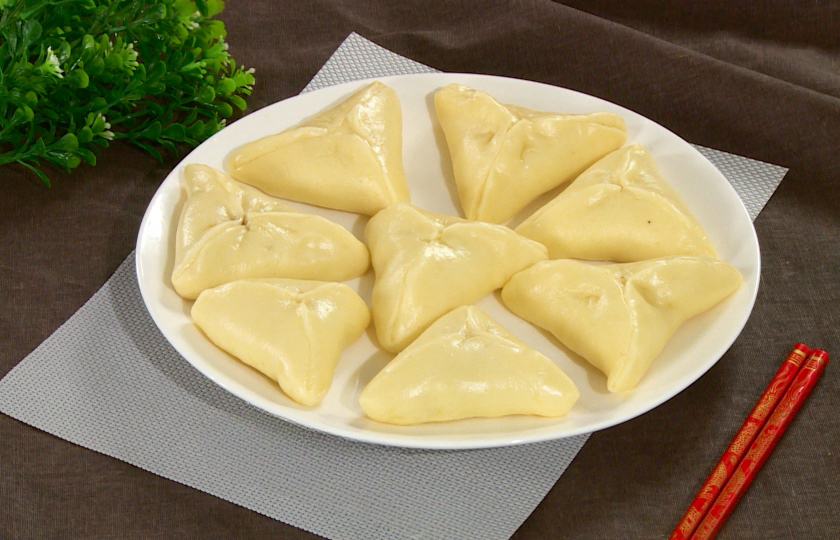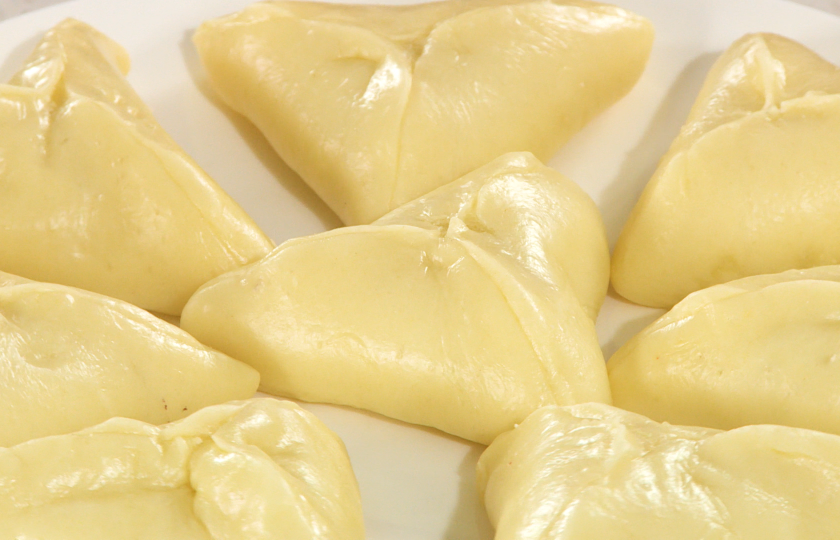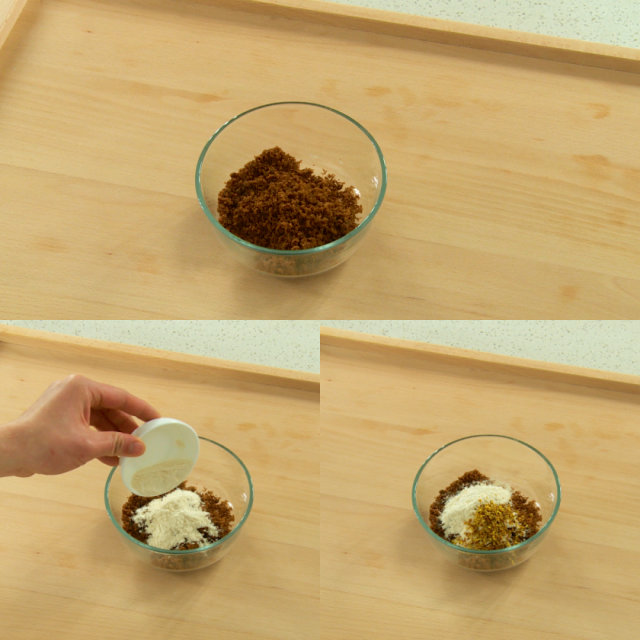Chinese Sugar Triangles


Sugar triangle is a classic traditional snack. The golden and crispy crust wraps the sweet sugar filling. Simple ingredients can bring surprising taste. Today, let's discuss how to make this delicious pastry.
Required raw materials and substitutes
To make this sugar triangle, you need to prepare the following materials:
Main ingredients
Brown sugar: It is the main component of the filling, providing a rich sweetness and unique flavor for the sugar triangle.
Flour: Ordinary flour is used to make dough. Cooked flour can make the texture of the filling more appropriate and not too thin and soft.
Osmanthus: Adds a unique osmanthus fragrance and enriches the flavor of the sugar triangle.
Accessories
Warm water and clear water: Mainly used for operations such as dissolving yeast and mixing dough.
Yeast: Used for fermenting dough to make the sugar triangle taste softer.
Baking powder: Assists fermentation and helps the dough expand better, making the finished product taste better.
Seasonings
White sugar: Increases sweetness and enhances the overall taste. It also helps dough fermentation.
Substitutes
If there is no brown sugar, dark brown sugar can be used as a substitute. The flavor is relatively similar, but there will be differences in sweetness and taste details.
Ordinary flour can be replaced with low-gluten flour or high-gluten flour. However, the dough made of low-gluten flour may be softer, and high-gluten flour is relatively more resilient, which will affect the taste of the finished product.
Osmanthus can be replaced with osmanthus sauce, which can also bring osmanthus fragrance. But pay attention to the dosage to avoid being too sweet.
Yeast can be selected as high-sugar-tolerant yeast, especially when there is more sugar, the fermentation effect is better. If there is no yeast, you can try to use old dough instead, but the fermentation time and operation difficulty will change.
Baking powder can be selected as aluminum-free baking powder, which is more healthy and environmentally friendly. If you don't want to use baking powder, you can appropriately increase the amount of yeast and extend the fermentation time to achieve a similar effect.
White sugar can be replaced with rock sugar powder, etc., but there will be differences in dissolution speed and other aspects.

What tools need to be prepared
Chopsticks: Play a role in dissolving yeast. For 3 grams of yeast in 5 milliliters of warm water, use chopsticks to stir evenly. When mixing flour, it can be stirred into flocculent shape for convenient subsequent operations.
Blender: Can efficiently mix dry ingredients. For example, flour, baking powder, and sugar can be quickly and evenly blended after being processed by a blender, which is beneficial for stable fermentation and texture shaping of the dough.
Cutting board: It is a platform for kneading dough. Put the flocculent dough on it and knead and press it into a smooth dough for 5 to 10 minutes. Its flatness affects the quality of the dough and then concerns the quality of sugar triangles.
Wet cloth or plastic wrap: Used for protection during fermentation. Wet cloth keeps moisture, and plastic wrap locks in water. The two create a suitable environment for the dough to fully ferment and expand within 1 to 1.5 hours.
Rolling pin: Responsible for rolling out the dough. Roll the small dough into a round piece 3 to 5 millimeters thick, with a thicker middle and thinner edges, which is convenient for wrapping fillings and beneficial for steaming, ensuring the taste and appearance of sugar triangles.
Steamer and steamer pot: Realize the steaming process of sugar triangles. Put the raw blanks in the steamer, and boil water in the steamer pot. Steam on high heat first and then on medium heat for 25 minutes to make the dough and fillings reach the best state.
What are the reasons for failure
Improper raw material ratio:
If the ratio of raw materials such as flour, yeast, and sugar is incorrect, it will lead to failure. For example, if there is too much flour, the dough will be too hard. If there is too little yeast, the dough will not ferment. Because yeast is the key to fermentation. If the amount is not enough, enough carbon dioxide cannot be produced to make the dough expand. And an inappropriate amount of sugar will also affect the activity of yeast. Too much sugar will inhibit yeast fermentation.
Yeast inactivation:
If the water temperature for dissolving yeast is too high or too low, the yeast will be inactivated. If the water temperature exceeds 60 degrees Celsius, the yeast will be scalded to death. If the water temperature is lower than 10 degrees Celsius, it is difficult to stimulate the activity of yeast. Moreover, if the yeast is expired, it cannot function normally, so that the dough cannot ferment and the sugar triangle will have a hard texture.
Insufficient kneading:
If the kneading time is too short, the gluten in the dough is not fully formed. In this way, the dough will not have enough elasticity and toughness. It is easy to break during the process of wrapping fillings or steaming. And the taste will also be relatively poor, not soft and chewy enough.
Fermentation problems:
In addition to the failure of fermentation caused by yeast inactivation, inappropriate fermentation environment will also cause problems. If the environment is too dry, the surface of the dough will crack. If the temperature is too low, the fermentation speed will be too slow or even stop. If the temperature is too high, the yeast may die and the dough will become sour.
Filling problems:
If the brown sugar filling is not stirred evenly, there will be some places that are too sweet and some places that are tasteless after wrapping. Moreover, if the filling is too wet, it is easy to leak out during the wrapping process, affecting the shaping of sugar triangles.
Improper steaming:
If the steaming time is too short, the filling inside the sugar triangle may not be cooked, and it will taste like raw flour. If the time is too long, the sugar triangle may collapse and deform, and the dough skin will also become wet and sticky, affecting the taste and appearance.
How to judge if fermentation is complete
Fermentation standard: The dough should expand to twice its original size. The surface should be round and full like a balloon. You can stick a mark on the outside of the basin to observe where the dough rises. Fermentation time is longer in winter and shorter in summer.
Judgment by feel: There are three situations when gently poking the dough. If it does not rebound when pressed, it means fermentation is insufficient and needs to wait longer. If it springs back immediately when pressed, it means it is over-fermented and you need to knead the dough again. Pressing it and having it rebound slowly is the most appropriate. At this time, you can start the next step.
Odor change: When fermentation is just right, there will be a faint wine aroma. This is the best state of the dough. If it smells sour or has a strange smell, it means fermentation has been too long. Beginners had better start observing a few minutes in advance so that it is easier to master the degree of fermentation.
Surface characteristics: It is normal for the surface of the dough to change from matte at the beginning to shiny. If there are wrinkles or cracks on the surface, it is a sign of over-fermentation. The fermentation environment should maintain a stable temperature and cannot be alternately hot and cold.
INGREDIENTS
Main Ingredients
-
·30g brown sugar
-
·15g cooked flour
-
·2g osmanthus
-
·50g flour
Additional Ingredients
-
·5ml warm water
-
·20ml clear water
-
·3g yeast
-
·2g baking powder
Seasonings
-
·10g white sugar
COOKING STEP
Step 1
Prepare filling ingredients: Weigh 30 grams of brown sugar, 15 grams of cooked flour and 2 grams of osmanthus respectively and set aside.

Step 2
Make brown sugar filling: Pour brown sugar, cooked flour and osmanthus into a bowl and stir evenly with a spoon until a uniformly textured filling is formed and set aside.

Step 3
Dissolve yeast: Put 3 grams of yeast into 5 milliliters of warm water and stir gently with chopsticks to completely dissolve the yeast in warm water to form a yeast solution.

Step 4
Mix dry ingredients: Pour 50 grams of flour, 2 grams of baking powder and 10 grams of white sugar into a large bowl and stir evenly with chopsticks or a mixer to ensure that all dry ingredients are fully mixed.

Step 5
Prepare dough: Slowly pour the yeast solution into the mixed dry ingredients. At the same time, add 20 milliliters of clear water. Stir with chopsticks while pouring until it forms a flocculent state.

Step 6
Divide the dough: Take out the fermented dough and place it on the cutting board. Gently knead to release air. Then roll it into a long strip and evenly divide it into small dough pieces of about 1-2 centimeters each with a knife.

Step 7
Roll out the dough skin: Roll each small dough piece into a round dough skin with a thicker middle and thinner edges using a rolling pin. The thickness is about 3-5 millimeters.

Step 8
Wrap and shape: Take a piece of dough skin, put about three small spoonfuls of brown sugar filling on it, and then pinch the edges of the dough skin in turn to form a triangle. The pinched part should be tight to prevent the filling from leaking out.

Step 9
Steam: Put the raw sugar triangles wrapped with filling into a steamer, leaving a certain gap between each. Add an appropriate amount of water to the steamer. After boiling vigorously, put the steamer in and turn to medium heat and steam for 25 minutes.

Step 10
Completion: After steaming, open the lid and take it out carefully. In this way, the delicious sugar triangle is completed.

More recipes worth trying
Rolling Donkey: A Beijing Snack with Cultural Charm
Aiwowo recipe(Glutinous Rice Balls with Sweet Filling)
Can it be frozen for storage
Sugar triangles can be refrigerated for up to 3 days or frozen for 1 month. However, the freshly steamed ones have the best taste. It is recommended to eat them as soon as they are made.
Before putting it in the refrigerator, it must be completely cooled and sealed well with a fresh-keeping box or fresh-keeping bag. The refrigerated ones can be eaten after being heated in the microwave for 15 seconds. The frozen ones need to be warmed up for 10 minutes first and then steamed for 3 minutes.
However, whether it is refrigerated or frozen, the taste is not as good as that just out of the pot. The dough skin will become slightly harder and the sugar filling will not be so fragrant. So it is best to make according to the amount of food consumed by your family. Don't make too much at one time. Making and steaming on demand is the best choice.
Serving Suggestions
Eating temperature: Sugar triangles are most suitable for eating warm. Cooling for 2 minutes just out of the pot is the best state. At this time, the dough skin is soft and glutinous, and the sugar filling is sweet and rich, with the richest taste levels.
Drink pairing: For breakfast, it can be paired with warm soybean milk or milk. For afternoon tea, Longjing tea or black tea are both very suitable. The tea aroma can neutralize the sweetness and make the taste more balanced. Drinking hot drinks in winter and pairing with herbal tea in summer are both fine.
Eating method: It is recommended to gently break it open by hand for eating. Do not pierce it with chopsticks to avoid syrup overflowing. Be careful with the first bite. The temperature of the syrup inside may still be very high. Because of the high sweetness, it is best to taste it slowly. Don't be greedy at one time. Pairing with drinks can better experience the deliciousness.
FAQs:
Preventive measures: Put less water when making dough. It is recommended to add 80% of the water first and add more if needed. Choose medium-gluten flour. Knead the dough thoroughly. The dough should be kneaded until the surface is smooth and tough. Observe the softness and hardness of the dough at any time during the whole process and adjust it in time.
The dough is too soft mainly because too much water is added or the flour is not evenly stirred. A too soft dough is not easy to operate. It is easy to stick to hands and the cutting board. When wrapping fillings, it is easy to break, affecting the taste and appearance of the final product.
The kneading action should be continuous: First push and press the dough outward and then fold it back. Repeat this action. The strength should be moderate. It cannot be too strong to cause the gluten to break, nor too light to knead out toughness. Generally, after kneading for about 10 minutes, the surface of the dough will become smooth and elastic.
Judgment standard: Whether the dough is kneaded enough mainly depends on the appearance and feel. A good dough feels tough. The surface is smooth and delicate. When pressed with a finger, it will rebound slowly. When pulled, it will not break. If the dough is sticky or particularly hard, adjust the water in time and continue kneading.
If you want to wrap it into a steamed twisted roll shape, the dough should be rolled a little thinner. Sprinkle sugar on it and then roll it up. Cut it into sections and place them vertically for steaming. It can also be wrapped into a tea towel bag shape or pinched into a pleated dumpling shape. However, these shapes require certain techniques.
When lifting the lid, pay attention to slow movements. It is best to open it sideways to let the steam slowly dissipate. After opening the lid, don't take it out immediately. Wait for another minute to let the sugar triangle cool down naturally. At this time, the sugar filling will also solidify slightly and will not be too hot. It is best to use chopsticks when taking it out so as not to break the dough skin.

















